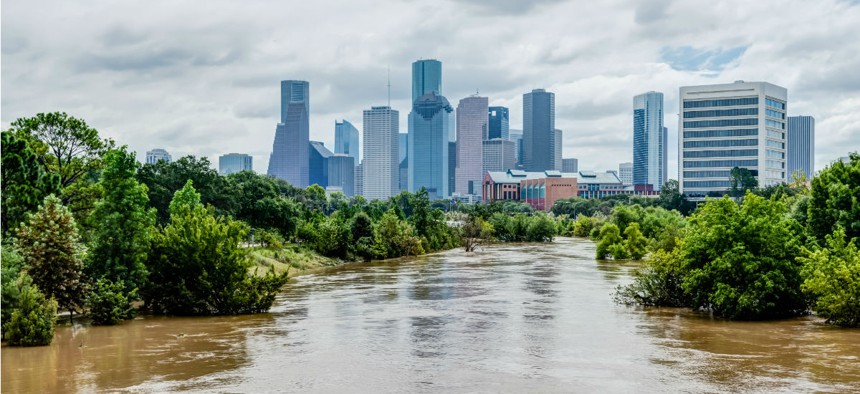
Hurricane Harvey spawned torrential downpours that caused widespread flooding in Houston and much of eastern Texas. Shutterstock.com
A Program Providing Vital Data to Threatened Citizens Is Itself at Risk
NOAA’s Digital Coast platform gives vulnerable communities access to critical information during natural disasters.
The 2017 hurricane season produced a number of epic storms. In just one week, we watched Harvey inundate the Houston area with floodwaters and Irma’s high winds and rain devastate large swaths of Florida, Georgia and South Carolina, along with several Caribbean nations. Those storms were quickly followed by Maria, which ravaged Puerto Rico and the U.S. Virgin Islands. For those in the path of a storm, information about the local geography is critical for planning, responding to and recovering from damages. But many state and local jurisdictions do not have human, technical and financial resources to produce detailed GIS maps that can flag the potential implications of natural disasters on their communities.
That’s where the National Oceanic and Atmospheric Administration’s Digital Coast initiative comes in. The Digital Coast website is a centralized platform that brings together resources to provide communities with access to valuable data, tools and training that they may not be able to procure themselves. Using this information, they can better address issues such as flooding, storm surges and rising sea levels, which threaten lives and livelihoods.
Use of the Digital Coast site skyrocketed in the seven days from the start of Hurricane Harvey to the U.S. landfall of Irma. Overall, users and online sessions grew dramatically during that week, with the Sea Level Rise and Coastal Flooding Impacts tool seeing nearly an 800 percent spike in visits compared to the week prior. Similarly, visits to the Historical Hurricane Tracks tool rose nearly 200 percent. With these tools, users could visualize community-level impacts from coastal flooding, including photo simulations of future flooding potential, and gain a clearer understanding of coastal population and hurricane strike data for counties from Maine to Texas.
Meeting a Critical Need
While the coastlines surrounding oceans, bays and lakes may account for only about 10 percent of the U.S. land area, a NOAA study revealed that nearly 40 percent of the U.S. population—more than 123 million people—live in coastal zones. More critically perhaps, that number is projected to grow to almost 133 million people by 2020.
More frequent severe weather, such as we’ve seen this hurricane season, or historical storms like Sandy and Katrina, combined with rising sea levels and natural disasters continue to change landscapes, putting natural habitats, the economy and citizens’ lives at risk. Digital Coast was launched in 2007 with these concerns in mind.
As a central repository of information for the coastal management community, the Digital Coast website hosts content from hundreds of sources—non-governmental organizations; city, county, state and federal governments; private companies; and academia—all of which are vetted by NOAA. There are more than 115 collections, including bathymetric (underwater depths of lake or ocean floors) and topographic (surface of the earth) imagery, weather radar and elevation data, as well as nearly 1,900 individual data sets.
Beyond this valuable data, Digital Coast also provides state, county and local governments with tools, training and resources so they can better understand the raw data sets. Without Digital Coast, these entities often have little or no access to such tools and computing power, or expertise in using them. Digital Coast fills this gap by providing visualization and predictive tools, and search capabilities, that make data easier to find and understand. NOAA also provides online training or courses at users’ location if organizations need assistance using the tools.
In its first decade, Digital Coast has delivered more than $25 million worth of net benefits, and, with continued operation over the next 15 years, it is expected to reach $117 million. But these benefits to communities across the country could be at risk as a result of current political turmoil and potential NOAA budget cuts, which could prove disastrous for the communities and population impacted by even fiercer hurricanes.
Preserving and Extending Benefits
In January 2017, Sen. Tammy Baldwin, D-Wisc., introduced the Digital Coast Act (S.110). The bipartisan bill (co-sponsored by Sens. Lisa Murkowski, R-Alaska; Dan Sullivan, R-Alaska; and Cory Booker, D-N.J.) would build on the success of the Digital Coast program through development of deeper data sets in new frontiers, like Alaska—which spans more than 5,580 miles of coastlines—and Arctic areas, where high-resolution LiDAR or satellite coverage is scant. But perhaps the most important part of the bill is its proposal to make the Digital Coast initiative an official government program, authorizing $4 million for each fiscal year between 2018 and 2022, which is critical to its continued success in the face of proposed federal budget cuts.
Already the Digital Coast program has proven the effectiveness of its public-private partnership model with a substantial return on investment and growing usage. It is a unique resource that provides city planners, developers, environmentalists, and even private citizens, with the ability to see how communities and natural resources could be impacted coastal development, weather trends and sea level rise.
The Digital Coast Act passed the Senate in May. Now it is time for House lawmakers to advance this legislation. More than ever, citizens and communities need access to the valuable information and analytical tools available on the Digital Coast platform to support economic development, protect natural resources, and prevent or respond to costly disasters.
Kurt Allen is a vice president at Quantum Spatial, Inc. (QSI), where he manages the company's Federal business. His responsibilities include leading QSI’s Government Affairs Program and educating Congress on geospatial programs of significance.






